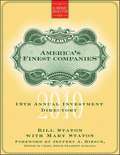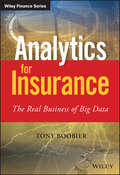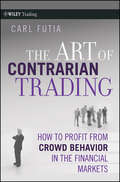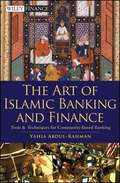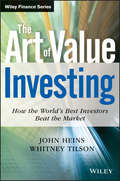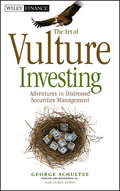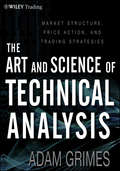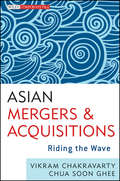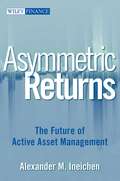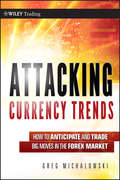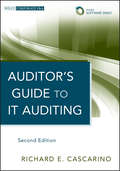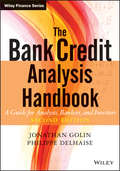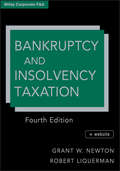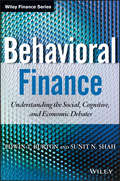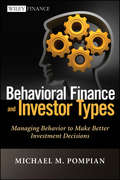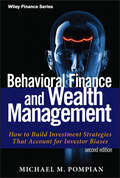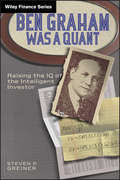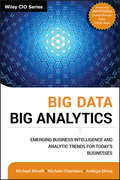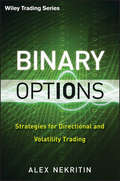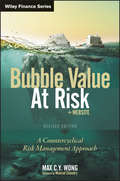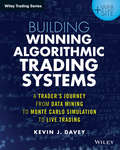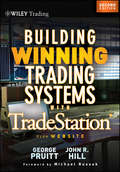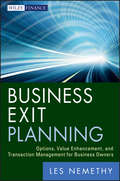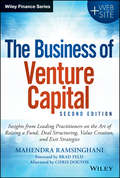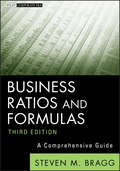- Table View
- List View
America's Finest Companies 2010
by Mary Staton Bill Staton HirschA detailed look at the best American companies to invest inAmerica's Finest Companies 2010 (now in its 19th annual edition) is a reliable guide to investing, containing every publicly traded company in the United States with at least ten consecutive years of higher dividends and/or earnings per share.With this detailed directory, Bill Staton--a successful financial advisor and money manager for almost four decades--shares his simple, time-tested way to make your money grow at an above-average rate with substantially reduced risk. The companies found here are well-run and profitable, and with long histories of rising annual dividends and/or earnings, they are sure to boost the bottom line of any portfolio.Offers essential insights into building a portfolio of American companies with rising annual dividends and/or earningsContains new listings and delistings as well as a break down of companies by industryFilled with thoughtful editorial pieces such as "Dow 30,000 by 2018", "Trends Don't Go On Forever", and "Turning Chaos Into Tremendous Opportunity"America's Finest Companies 2010 will help you rebuild your portfolio and keep it on sound financial footing for years to come. If you're looking to invest successfully, look no further than America's Finest Companies 2010.
Analytics for Insurance: The Real Business of Big Data
by Tony BoobierThe business guide to Big Data in insurance, with practical application insight Big Data and Analytics for Insurers is the industry-specific guide to creating operational effectiveness, managing risk, improving financials, and retaining customers. Written from a non-IT perspective, this book focusses less on the architecture and technical details, instead providing practical guidance on translating analytics into target delivery. The discussion examines implementation, interpretation, and application to show you what Big Data can do for your business, with insights and examples targeted specifically to the insurance industry. From fraud analytics in claims management, to customer analytics, to risk analytics in Solvency 2, comprehensive coverage presented in accessible language makes this guide an invaluable resource for any insurance professional. The insurance industry is heavily dependent on data, and the advent of Big Data and analytics represents a major advance with tremendous potential - yet clear, practical advice on the business side of analytics is lacking. This book fills the void with concrete information on using Big Data in the context of day-to-day insurance operations and strategy. Understand what Big Data is and what it can do Delve into Big Data's specific impact on the insurance industry Learn how advanced analytics can revolutionise the industry Bring Big Data out of IT and into strategy, management, marketing, and more Big Data and analytics is changing business - but how? The majority of Big Data guides discuss data collection, database administration, advanced analytics, and the power of Big Data - but what do you actually do with it? Big Data and Analytics for Insurers answers your questions in real, everyday business terms, tailored specifically to the insurance industry's unique needs, challenges, and targets.
The Art of Contrarian Trading
by Carl FutiaWhy is it so hard to beat the market? How can you avoid getting caught in bubbles and crashes? You will find the answers in Carl Futia's new book, The Art of Contrarian Trading. This book will teach you Futia's novel method of contrarian trading from the ground up. In 16 chapters filled with facts and many historical examples Futia explains the principles and practice of contrarian trading. Discover the Edge which separates winning speculators from the losers. Find out how to apply the No Free Lunch principle to identify profitable trading methods. Learn about the wisdom and the follies of investment crowds - and how crowds are formed by information cascades that drive stock prices too high or too low relative to fair value. Discover the power of your Media Diary - and how to use it to spot these information cascades, measure the strength of the crowd's beliefs, and decide when the crowd's view is about to be proven wrong. You will watch Futia apply these principles of contrarian trading to navigate safely and profitably through the last 26 tumultuous years of roller coaster swings in the U. S. stock market - a time during which Futia kept his own media diary and developed his Grand Strategy of Contrarian Trading. See how this Grand Strategy worked during the Great Bull Market of 1982-2000. Watch the Contrarian Rebalancing technique in practice during the dot. com crash of 2000-2002. Find out when the Aggressive Contrarian Trader bought and sold during the bull market of 2002-2007. Read about the causes of the Panic of 2008 and ups and downs of contrarian trading during that dangerous time. Futia shows you how the market turning points during the 1982-2008 period were foreshadowed by magazine covers and newspaper headlines that astonishingly and consistently encouraged investors to do the wrong thing at the wrong time. By monitoring crowd beliefs revealed by news media headlines - and with the guidance provided by the many historical examples Futia provides - a trader or investor will be well-equipped to anticipate and profit from market turning points.
The Art of Islamic Banking and Finance
by Yahia Abdul-RahmanA detailed look at the fast-growing field of Islamic banking and financeThe Art of Islamic Banking and Finance is a modern American take on what it means to incorporate Islamic finance principles into everyday banking and investment techniques by introducing a new brand of banking for all people of all faiths: The Riba-Free (RF) banking.The author is considered the father of RF (Islamic) banking in America. He has been a banker and an Imam/scholar for over 40 years in America since 1968. He started the tedious process with a finance company, LARIBA, in Pasadena, California in 1987. This is the first book ever in the field to trace the origins of prohibiting the renting of money at a price called interest rate and over-indulging in debt. The book reviews in great details the theological foundations of prohibiting interest in the Jewish Bible, the Christian Bible, and the Qur'aan. The author then discusses money and how fiat money is created, the role of the Federal Reserve, and the banking system in America. The book also discusses for the first time ever how to include an important aspect of RF (Islamic) finance using commodity indexation and marking the items to be financed to market in order to avoid participating in economic "bubbles." The author discusses how these rules work, how they affect consumer behavior, and how they change the role of the banker/financier.Covers a new pioneering model that is based on the Law (Shari'aa) and how it is applied in every transaction from joint ventures and portfolio management to home mortgages and personal financingShows how to incorporate the Law (Shari'aa) into American financing and banking systemsPoints to RF (Islamic) finance and banking as a way to emphasize socially responsible investingThe Art of Islamic Banking and Finance also includes a discussion on the emergence of a culture of RF (Islamic) banking and finance today, which is based on the real Judeo-Christian-Islamic spirit and very effective when compared to twentieth-century models that use financial engineering and structuring techniques to circumvent the Law (Shari'aa). The book also includes case studies based on the actual experience of the author and detailed analysis of the superior results realized by applying this new brand of banking to financing.
The Art of Value Investing
by John Heins Whitney TilsonSays Bill Ackman of Pershing Square Capital Management about The Art of Value Investing: "I learned the investment business largely from the work and thinking of other investors. The Art of Value Investing is a thoughtfully organized compilation of some of the best investment insights I have ever read. Read this book with care. It will be one of the highest-return investments you will ever make. " Based on interviews with the world's most-successful value investors, The Art of Value Investing offers a comprehensive set of answers to the questions every equity money manager should have thought through clearly before holding himself or herself out as a worthy steward of other people's money. What market inefficiencies will I try to exploit? How will I generate ideas? What will be my geographic focus? What analytical edge will I hope to have? What valuation methodologies will I use? What time horizon will I typically employ? How many stocks will I own? How specifically will I decide to buy or sell? Will I hedge, and how? How will I keep my emotions from getting the best of me? Who should read The Art of Value Investing? It is as vital a resource for the just starting out investor as for the sophisticated professional one. The former will find a comprehensive guidebook for defining a sound investment strategy from A-to-Z; the latter will find all aspects of his or her existing practice challenged or reconfirmed by the provocative thinking of their most-successful peers. It also is a must read for any investor - institutional or individual - charged with choosing the best managers for the money they are allocating to equities. Choosing the right managers requires knowing all the right questions to ask as well as the answers worthy of respect and attention - both of which are delivered in The Art of Value Investing.
The Art of Vulture Investing
by George J. Schultze Janet LewisA detailed and compelling look at distressed securities investing in today's market In the corporate world, "vulture" investors in distressed securities serve the same cleanup function as vultures do in the natural world: they deal with failing companies, digest bad debt, and mop up after bankruptcies. Since this market's structural and legal complexities create greater inefficiencies than in other investment fields, it's a style of investing that can make money during both booms and busts. While recent economic carnage has made opportunities for vulture investors, more convoluted bankruptcies, conflicts of interest, and even government intervention have made this arena harder to negotiate. Nobody understands this better than author George Schultze, founder of Schultze Asset Management. During his successful career as a vulture investor, he's learned a number of lessons and developed an investment philosophy that has served him well. Now, in The Art of Vulture Investing, Schultze shares his valuable insights and experiences with you. Engaging and informative, this reliable guide offers a bird's-eye into the opportunities and risks associated with vulture investing. And while it may not always be pretty, you'll see exactly why this process is necessary for our economic ecosystem. Throughout this book, Schultze explains the theory and strategy of vulture investing in clear and lively prose, illustrating each concept with examples from his own varied experience that show how the landscape has changed in recent years. Offers valuable information on distressed securities investing since the 2007-2009 financial crisis Examines the opportunities and dilemmas for modern vulture investors Includes in-depth case studies of high-profile bankruptcies, including those of Chrysler Automotive and Tropicana Casinos and Resorts By its very nature, investing in distressed companies can be a complicated and risky business. But once the dust settles, these investments can yield extraordinary profits. The Art of Vulture Investing puts this discipline in perspective and shows you how to excel at this difficult, yet rewarding, endeavor.
The Art & Science of Technical Analysis
by Adam GrimesA breakthrough trading book that provides powerful insights on profitable technical patterns and strategiesThe Art and Science of Technical Analysis is a groundbreaking work that bridges the gaps between the academic view of markets, technical analysis, and profitable trading. The book explores why randomness prevails in markets most, but not all, of the time and how technical analysis can be used to capture statistically validated patterns in certain types of market conditions. The belief of the book is that buying and selling pressure causes patterns in prices, but that these technical patterns are only effective in the presence of true buying/selling imbalance.The Art and Science of Technical Analysis is supported by extensive statistical analysis of the markets, which will debunk some tools and patterns such as Fibonacci analysis, and endorse other tools and trade setups. In addition, this reliable resource discusses trader psychology and trader learning curves based on the author's extensive experience as a trader and trainer of traders.Offers serious traders a way to think about market problems, understand their own performance, and help find a more productive path forwardIncludes extensive research to validate specific money-making patterns and strategiesWritten by an experienced market practitioner who has trained and worked with many top tradersFilled with in-depth insights and practical advice, The Art and Science of Technical Analysis will give you a realistic sense of how markets behave, when and how technical analysis works, and what it really takes to trade successfully.
Asian Mergers and Acquisitions
by Soon Ghee Chua Vikram ChakravartyA fascinating look at the unique nature of mergers and acquisitions in AsiaThe Asian market is heating up, and both local and international firms are looking to get in on the mergers and acquisitions (M&As) that are poised to play a pivotal role in the restructuring of all manner of industries. This restructuring will increase competitiveness, but to make the most of it you need to understand why M&As in Asia are unique. With Asian Mergers and Acquisitions: Riding the Wave in hand, you have everything you need to do just that.Packed with invaluable information on how Asian M&As work, the book points to the fragmented nature of Asian countries, markets, and customers, the rise of Asian economies and firms, and the growth of cross-border business driven by the need for companies to gain access to markets, technologies, and brands as key elements for understanding the market.Lays out guiding principles for Asian M&As, including identifying the drivers for creating value, mitigating cultural differences, getting the best expertise in pre- and post-merger efforts, and moreContains everything investors need to know to understand coming changes in the Asian marketDetails how Asian M&As differ from those in other countriesProviding clear insights into Asian mergers and acquisitions and their inner workings, including do's and don'ts for successful investment, this book is essential reading for anyone looking to cash in--or simply understand-- the rapid growth of Asian industry.
Asymmetric Returns
by Alexander M. IneichenIn Asymmetric Returns, financial expert Alexander Ineichen elevates the critical discussion about alpha versus beta and absolute returns versus relative returns. He argues that controlling downside volatility is a key element in asset management if sustainable positive compounding of capital and financial survival are major objectives. Achieving sustainable positive absolute returns are the result of taking and managing risk wisely, that is, an active risk management process where risk is defined in absolute terms and changes in the market place are accounted for. The result of an active risk management process-when successful-is an asymmetric return profile, that is, more and higher returns on the upside and fewer and lower returns on the downside. Ineichen claims that achieving Asymmetric Returns is the future of active asset management.Alexander M. Ineichen, CFA, CAIA, is Managing Director and Senior Investment Officer for the Alternative Investment Solutions team, a key provider within Alternative and Quantitative Investments, itself a business within UBS Global Asset Management. He is also on the Board of Directors of the Chartered Alternative Investment Analyst Association (CAIAA). Ineichen is the author of the two UBS research publications In Search of Alpha--Investing in Hedge Funds (October 2000) and The Search for Alpha Continues--Do Fund of Hedge Funds Add Value? (September 2001). As of 2006 these two reports were the most often printed research papers in the documented history of UBS. He is also author of the widely popular Absolute Returns--The Risk and Opportunities of Hedge Fund Investing, also published by John Wiley & Sons.
Attacking Currency Trends
by Greg MichalowskiThe guide for reading long-term trends in the foreign currency marketTo thrive in the marketplace traders must anticipate, enter, and stay with trends in the foreign exchange market.In this much-needed guide top forex, expert Greg Michalowski clearly explains the attributes of successful traders, and shows how traders can set themselves up for success by drafting an explicit mission statement and game plan. The book also contains the tools and techniques traders need to read the markets and identify when a market is in a trend. Michalowski shows traders how to enter an emerging trend, how to manage the position, and how to exit the position most effectively.Includes the technical tools needed to invest in the foreign exchange market: moving averages, trendlines, and Fibonacci levelsShows how to identify a trend and stick with the trend through its durationWritten by Greg Michalowski who was cited by SmartMoney magazine as a "go to" source for making money movesWith this book, Michalowski offers an important resource for identifying and riding out long-term trends in the volatile foreign currency.
Auditor's Guide to IT Auditing
by Richard E. CascarinoStep-by-step guide to successful implementation and control of IT systems--including the CloudMany auditors are unfamiliar with the techniques they need to know to efficiently and effectively determine whether information systems are adequately protected. Now in a Second Edition, Auditor's Guide to IT Auditing presents an easy, practical guide for auditors that can be applied to all computing environments.Follows the approach used by the Information System Audit and Control Association's model curriculum, making this book a practical approach to IS auditingServes as an excellent study guide for those preparing for the CISA and CISM examsIncludes discussion of risk evaluation methodologies, new regulations, SOX, privacy, banking, IT governance, CobiT, outsourcing, network management, and the CloudAs networks and enterprise resource planning systems bring resources together, and as increasing privacy violations threaten more organization, information systems integrity becomes more important than ever. Auditor's Guide to IT Auditing, Second Edition empowers auditors to effectively gauge the adequacy and effectiveness of information systems controls.
The Bank Credit Analysis Handbook
by Jonathan Golin Philippe DelhaiseA hands-on guide to the theory and practice of bank credit analysis and ratings In this revised edition, Jonathan Golin and Philippe Delhaise expand on the role of bank credit analysts and the methodology of their practice. Offering investors and practitioners an insider's perspective on how rating agencies assign all-important credit ratings to banks, the book is updated to reflect today's environment of increased oversight and demands for greater transparency. It includes international case studies of bank credit analysis, suggestions and insights for understanding and complying with the Basel Accords, techniques for reviewing asset quality on both quantitative and qualitative bases, explores the restructuring of distressed banks, and much more. Features charts, graphs, and spreadsheet illustrations to further explain topics discussed in the text Includes international case studies from North America, Asia, and Europe that offer readers a global perspective Offers coverage of the Basel Accords on Capital Adequacy and Liquidity and shares the authors' view that a bank could be compliant under those and other regulations without being creditworthy A uniquely practical guide to bank credit analysis as it is currently practiced around the world, The Bank Credit Analysis Handbook, Second Edition is a must-have resource for equity analysts, credit analysts, and bankers, as well as wealth managers and investors.
Bankruptcy and Insolvency Taxation
by Robert Liquerman Grant W. NewtonThe thousands of mergers, acquisitions, and start-ups that have characterized the past years of business have created an increasing number of corporations in financial trouble: specifically, a shortage of venture capital or quick cash. Consequently, bankruptcy protection is now viewed as a strategic move to protect corporations from their creditors and allow them to reorganize. Fully revised and updated with new case studies and the latest coverage of regulations, Bankruptcy and Insolvency Taxation, Fourth Edition provides the answers to the questions financial managers will have on the tax aspects of bankruptcy strategy.
Behavioral Finance
by Edwin T. Burton Sunit N. ShahAn in-depth look into the various aspects of behavioral finance Behavioral finance applies systematic analysis to ideas that have long floated around the world of trading and investing. Yet it is important to realize that we are still at a very early stage of research into this discipline and have much to learn. That is why Edwin Burton has written Behavioral Finance: Understanding the Social, Cognitive, and Economic Debates. Engaging and informative, this timely guide contains valuable insights into various issues surrounding behavioral finance. Topics addressed include noise trader theory and models, research into psychological behavior pioneered by Daniel Kahneman and Amos Tversky, and serial correlation patterns in stock price data. Along the way, Burton shares his own views on behavioral finance in order to shed some much-needed light on the subject. Discusses the Efficient Market Hypothesis (EMH) and its history, and presents the background of the emergence of behavioral finance Examines Shleifer's model of noise trading and explores other literature on the topic of noise trading Covers issues associated with anomalies and details serial correlation from the perspective of experts such as DeBondt and Thaler A companion Website contains supplementary material that allows you to learn in a hands-on fashion long after closing the book In order to achieve better investment results, we must first overcome our behavioral finance biases. This book will put you in a better position to do so.
Behavioral Finance and Investor Types
by Michael PompianAchieve investing success by understanding your behavior typeThis groundbreaking book shows how to invest wisely by managing your behavior, and not just your money. Step by step, Michael Pompian (a leading authority in the practical application of Behavioral Finance concepts to wealth management) helps you plan a strategy targeted to your personality. The book includes a test for determining your investment type and offers strategies you can put into use when investing. It also includes a brief history of the stock market, and easy-to-comprehend information about stocks and investing to help you lay a solid foundation for your investment decisions.Behavioral Finance and Investor Types is divided into two parts. Test Your Type, gives an overview of Behavioral Finance as well as the elements that come into play when figuring out BIT, like active or passive traits, risk tolerance, and biases. The book includes a quiz to help you discover what category you are in. Plan and Act, contains the traits common to your type; an analysis of the biases associated with your type; and strategies and solutions that compliment and capitalize on your BIT.Offers a practical guide to an investing strategy that fits both your financial situation and your personality typeIncludes a test for determining your tolerance for risk and other traits that will determine your investment typeWritten by the Director of the Private Wealth Practice for Hammond Associates--an investment consulting firm serving institutional and private wealth clientsBehavioral Finance and Investor Types offers investors a better sense of what drives them and what puts on their breaks. By using the information found here, you'll quickly become savvy about the world of investing because you'll come to understand your place in it.
Behavioral Finance and Wealth Management
by Michael M. PompianThe book that applies behavioral finance to the real world Understanding how to use behavioral finance theory in investing is a hot topic these days. Nobel laureate Daniel Kahneman has described financial advising as a prescriptive activity whose main objective should be to guide investors to make decisions that serve their best interests. The reality? That's easier said than done. In the Second Edition of Behavioral Finance and Wealth Management, Michael Pompian takes a practical approach to the growing science of behavioral finance, and puts it to use for real investors. He applies knowledge of 20 of the most prominent individual investor biases into "behaviorally-modified" asset allocation decisions. Offering investors and financial advisors a "self-help" book, Pompian shows how to create investment strategies that leverage the latest cutting edge research into behavioral biases of individual investors. This book: Shows investors and financial advisors how to either moderate or adapt to behavioral biases, in order to improve investment results and identifies "the best practical allocation" for investment portfolios. Using these two sound approaches for guiding investment decision-making, behavioral biases are incorporated into the portfolio management process Uses updated cases studies to show investors and financial advisors how an investor's behavior can be modified to improve investment decision-making Provides useable methods for creating behaviorally modified investment portfolios, which may help investors to reach their long term financial goals Heightens awareness of biases so that financial decisions and resulting economic outcomes are improved Offers advice on managing the effects of each bias in order to improve investment results This Second Edition illustrates investors' behavioral biases in detail and offers financial advisors and their clients practical advice about how to apply the science of behavioral finance to improve overall investment decision making.
Ben Graham Was a Quant
by Steven P. GreinerInnovative insights on creating models that will help you become a disciplined intelligent investorThe pioneer of value investing, Benjamin Graham, believed in a philosophy that continues to be followed by some of today's most successful investors, such as Warren Buffett. Part of this philosophy includes adhering to your stock selection process come "hell or high water" which, in his view, was one of the most important aspects of investing.So, if a quant designs and implements mathematical models for predicting stock or market movements, what better way to remain objective, then to invest using algorithms or the quantitative method? This is exactly what Ben Graham Was a Quant will show you how to do. Opening with a brief history of quantitative investing, this book quickly moves on to focus on the fundamental and financial factors used in selecting "Graham" stocks, demonstrate how to test these factors, and discuss how to combine them into a quantitative model.Reveals how to create custom screens based on Ben Graham's methods for security selectionAddresses what it takes to find those factors most influential in forecasting stock returnsExplores how to design models based on other styles and international strategiesIf you want to become a better investor, you need solid insights and the proper guidance. With Ben Graham Was a Quant, you'll receive this and much more, as you learn how to create quantitative models that follow in the footsteps of Graham's value philosophy.
Big Data, Big Analytics
by Michael Minelli Michele Chambers Ambiga DhirajUnique prospective on the big data analytics phenomenon for both business and IT professionalsThe availability of Big Data, low-cost commodity hardware and new information management and analytics software has produced a unique moment in the history of business. The convergence of these trends means that we have the capabilities required to analyze astonishing data sets quickly and cost-effectively for the first time in history. These capabilities are neither theoretical nor trivial. They represent a genuine leap forward and a clear opportunity to realize enormous gains in terms of efficiency, productivity, revenue and profitability.The Age of Big Data is here, and these are truly revolutionary times. This timely book looks at cutting-edge companies supporting an exciting new generation of business analytics.Learn more about the trends in big data and how they are impacting the business world (Risk, Marketing, Healthcare, Financial Services, etc.)Explains this new technology and how companies can use them effectively to gather the data that they need and glean critical insightsExplores relevant topics such as data privacy, data visualization, unstructured data, crowd sourcing data scientists, cloud computing for big data, and much more.
Binary Options
by Alex NekritinThe first comprehensive guide to trading a unique class of options to manage risk and make smarter bets during volatile tradingProviding savvy market players with a way to react quickly to event-driven opportunities and trends, exchange traded binary options are a unique type of derivative instrument offering fixed risk and reward. Available on four asset classes--stock index futures, commodity futures, Spot Forex and economic data releases--they are distinctly different from regular put/call options in that their pay-out structure offers only two potential outcomes, or settlement values: 0 or 100. The first guide focussing exclusively on this fast-growing sector of the options market, Trading Binary Options examines the key differences between regular options trading and binary options trading and describes how binary trading is done. It also gives you the lowdown on the most successful binary trading strategies and how and when they should be deployed. Outlines a rigorous approach to trading directionally around specific events, such as an earnings release, a shift in currencies, or a release of economic dataProvides the first comprehensive coverage of an increasingly popular but poorly understood trading instrumentOffers in-depth discussions of the six characteristics that distinguish binaries from other options and that make them such an attractive vehicle for hedging risk and improving returns
Bubble Value at Risk
by Max C. WongIntroduces a powerful new approach to financial risk modeling with proven strategies for its real-world applicationsThe 2008 credit crisis did much to debunk the much touted powers of Value at Risk (VaR) as a risk metric. Unlike most authors on VaR who focus on what it can do, in this book the author looks at what it cannot. In clear, accessible prose, finance practitioners, Max Wong, describes the VaR measure and what it was meant to do, then explores its various failures in the real world of crisis risk management. More importantly, he lays out a revolutionary new method of measuring risks, Bubble Value at Risk, that is countercyclical and offers a well-tested buffer against market crashes.Describes Bubble VaR, a more macro-prudential risk measure proven to avoid the limitations of VaR and by providing a more accurate risk exposure estimation over market cyclesMakes a strong case that analysts and risk managers need to unlearn our existing "science" of risk measurement and discover more robust approaches to calculating risk capitalIllustrates every key concept or formula with an abundance of practical, numerical examples, most of them provided in interactive Excel spreadsheetsFeatures numerous real-world applications, throughout, based on the author's firsthand experience as a veteran financial risk analyst
Building Algorithmic Trading Systems
by Kevin DaveyDevelop your own trading system with practical guidance and expert adviceIn Building Algorithmic Trading Systems: A Trader's Journey From Data Mining to Monte Carlo Simulation to Live Training, award-winning trader Kevin Davey shares his secrets for developing trading systems that generate triple-digit returns. With both explanation and demonstration, Davey guides you step-by-step through the entire process of generating and validating an idea, setting entry and exit points, testing systems, and implementing them in live trading. You'll find concrete rules for increasing or decreasing allocation to a system, and rules for when to abandon one. The companion website includes Davey's own Monte Carlo simulator and other tools that will enable you to automate and test your own trading ideas.A purely discretionary approach to trading generally breaks down over the long haul. With market data and statistics easily available, traders are increasingly opting to employ an automated or algorithmic trading system--enough that algorithmic trades now account for the bulk of stock trading volume. Building Algorithmic Trading Systems teaches you how to develop your own systems with an eye toward market fluctuations and the impermanence of even the most effective algorithm.Learn the systems that generated triple-digit returns in the World Cup Trading ChampionshipDevelop an algorithmic approach for any trading idea using off-the-shelf software or popular platformsTest your new system using historical and current market dataMine market data for statistical tendencies that may form the basis of a new systemMarket patterns change, and so do system results. Past performance isn't a guarantee of future success, so the key is to continually develop new systems and adjust established systems in response to evolving statistical tendencies. For individual traders looking for the next leap forward, Building Algorithmic Trading Systems provides expert guidance and practical advice.
Building Winning Trading Systems with TradeStation ®
by George Pruitt John R. HillThe updated edition of the guide to building trading systems that can keep pace with the market The stock market is constantly evolving, and coupled with the new global economic landscape, traders need to radically rethink the way they do business at home and abroad. Enter Building Winning Trading Systems, Second Edition, the all-new incarnation of the established text on getting the most out of the trading world. With technology now a pervasive element of every aspect of trading, the issue has become how to create a new system that meets the demands of the altered financial climate, and how to make it work. Giving voice to the question on every trader and investor's lips, the book asks, "How can we build a trading system that will be paramount for our increasingly stressed markets?" The answer? Establish mechanical trading systems that remove human emotion from the equation and form the cornerstone of a complete trading plan and with greater agility, characteristics that are more important than ever given the kinetic pace of the markets. Presents an all-new strategy for trading systems that will show traders how to create systems that will work in the twenty first century Expert advice from highly respected trading authority, George Pruitt Includes a new website featuring updated TradeStation code and shows how to use the world's best investment software platform to develop and utilize trading systems that really work Once again paving the way for traders who want to adapt to their environment, Building Winning Trading Systems, Second Edition combines expertise in indicator design and system building in one indispensable volume.
Business Exit Planning
by Les NemethyThe most viable exit strategies for owners of mid-sized companiesFor many business owners, cashing out of a business is a lifelong dream. For some, exiting a business can be a nightmare. Business Exit Planning: Options, Value Enhancement, and Transaction Management for Business Owners provides a comprehensive view of what every business owner needs to know to plan and execute a business exit. The bookIncludes 30 relevant mini-case studies on business exit planning and transaction management, as well as a glossary of frequently used technical termsDetails options for those owners who no longer want to be active in the business, as well as for those who want to remain investedCovers a wide range of topics related to business exit planning and transaction management, including IPO, MBO, refinancing, ESOPs, building an exit team, business plan and valuation, due diligence, and estate planningRegardless of whether a business owner seeks an immediate exit or a staged exit over time, Business Exit Planning provides a comprehensive strategy and road map to define exit-related objectives.
The Business of Venture Capital
by Mahendra RamsinghaniThe definitive guide demystifying the venture capital business The Business of Venture Capital covers the entire spectrum of a venture capital business, from raising venture funds to structuring investments, value creation as board member and assessing exit pathways. Author Mahendra Ramsinghani covers the distinct aspects of the venture capital fund raising and investment process with insights and perspectives from leading experts. Interviewees include Limited Partners (LPs) such as Credit Suisse, Grove Street Advisors and General Partners (GPs) from Foundry Group, Spark Capital, Benchmark Capital, Norwest Venture Partners, Shasta Ventures and Bessemer Venture Partners. If you're curious about venture capital businesses, you've found the only book that covers it all. - The first book to address the full investment cycle of the venture capital business - Demystifies the key aspects of the business - raising venture funds, fund-level due diligence and fund terms, structuring investments, value creation, and exits - Foreword by Mark Heesen, President, National Venture Capital Association - Benefit from the experiences of the best-in-class practitioners, who have made investments in leading companies like Zynga, Twitter & Foursquare - Describes how venture capital is an art as well as a science In-depth and thorough, The Business of Venture Capital is the one book that includes insights, tools and real world examples every practitioner can benefit from.
Business Ratios and Formulas
by Steven M. BraggA complete appraisal of analytical tools available to managers to assess performanceRequired reading for anyone starting, running, or growing a business, Business Ratios and Formulas, Third Edition puts answers at the fingertips of business managers, with nearly 250 operational criteria and clear, easy-to-understand explanations that can be used right away. The Third Edition includes twenty new measurements.Approximately 20 new measurementsOffers a comprehensive resource of nearly 250 operational criteriaAn Appendix including a dictionary of accounting and finance termsA thorough list of every ratio and formula, and how to compile and interpret that informationAlso by Steven M. Bragg: Fast Close: A Guide to Closing the Books Quickly, Second EditionAn ideal tool for measuring corporate performance, this authoritative resource allows you to pick and choose the tools you need to best assess your organization's performance.
